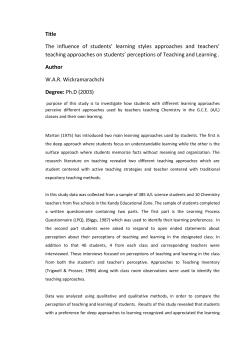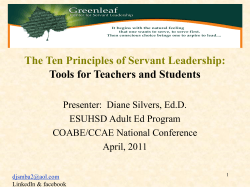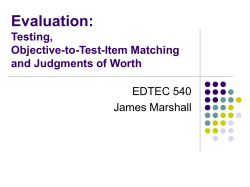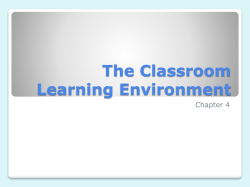
Analyze: Align Data Sources & Methods of Analysis
Assessment Field Notes Resource for Teaching Analyze: Align Data Sources & Methods of Analysis Analyzing outcomes assessment data is similar to the methods of analysis you are already familiar with in your discipline. To strengthen the conclusions you draw from your analyses combine measures that efficiently and effectively measure knowledge in addition to drawing on your expertise. The table below provides some examples of aligned data sources and methods. Data source Faculty-developed tests When linked to program learning outcomes (PLOs), collaboratively designed tests can provide direct evidence of mastery. Course-embedded assessment The instructional activities you already use can generate useful and direct evidence of student learning: • lab reports, research papers, theses • open-ended exam questions • oral presentations • formative assessment strategies (e.g., “minute essays,” entry/exit slips) Competence interviews Orally-administered exam which allows faculty to ascertain the breadth and depth of student understanding through conversation and questioning. • Can provide direct evidence of students’ mastery of learning outcomes (e.g. communicative skills in Spanish). Method of Analysis Considerations • Conduct item analysis to identify patterns of responses. • Calculate percentage of students who meet or exceed target threshold for each PLO. When embedded in a course or program, locally-developed tests create opportunities for assessing authentic student learning. • Important to check validity and reliability • Calculate percentage of students who meet or exceed target threshold for each PLO; identify change in students’ ability or performance over time. • Use content analysis to identify general themes, patterns, and frequency of responses. Course-embedded assessment is useful for instructors to provide feedback to students during the course AND calculate final course grades. • Use faculty-developed /adapted rubrics to calculate percentage of students who meet or exceed target threshold for each PLO. • Use content analysis to identify general themes, patterns, and frequency of responses. Reliability and validity can be vastly improved through the use of: • faculty-developed interview protocol • explicit scoring criteria • training and calibration among assessors (e.g. inter- rater reliability) Administer assessment at the beginning and end of a course to elicit information about changes in what students know and can do. • Can be time consuming. assessment@ucdavis.edu http://assessment.ucdavis.edu Data source Reflections Students respond to open-ended question(s) about an aspect of the course / program (e.g. What is the most valuable thing you learned as a result of this course?). • Can provide direct or indirect evidence of learning (direct assessment of students’ writing vs. indirect assessment of students’ beliefs / perceptions / attitudes, etc.). Surveys Gather indirect information about students’ beliefs, experiences, and / or attitudes. • Multiple formats allow faculty to invite different types of response (e.g. checklist, classification, frequency, importance, likeli hood, quality, quantitative judgment, ranking, etc.). Focus groups Provide opportunities for indepth exploration of potentially unanticipated results. • Can be combined with other data gathering strategies (e.g., surveys) to provide further triangulated information. Method of Analysis Considerations • Use faculty-developed / adapted rubrics to calculate percentage of students who meet or exceed target threshold for each PLO. • Use content analysis to identify general themes, patterns, and frequency of responses. • Validity depends on quality of questions / prompts. • Avoid bias with appropriate / effective sampling strategies. • Student perceptions of their own learning can be infor- mative to faculty (e.g. How well did this course / program help you develop your critical thinking skills?). • Percentage of self-reported satisfaction, learning, confidence, competence, perceptions. • Student perceptions of their own learning can be informative to faculty. • Validity depends on how questions are written / grouped, etc. • Avoid compound questions (e.g. What did you learn from this instructor and in this class?). • Focus on questions that will illicit actionable information. • Use content analysis of transcribed conversation(s) to identify general themes, patterns, and frequency of responses. • Requires a skilled, neutral facilitator. • Validity depends on the quality of questions. • Participants may not want to speak openly about their perceptions. • Can be time consuming. Using a mixed-approach (applying quantitative and qualitative analytic strategies) can reveal what students know, as well as why and how they learn. assessment@ucdavis.edu http://assessment.ucdavis.edu
© Copyright 2025





















